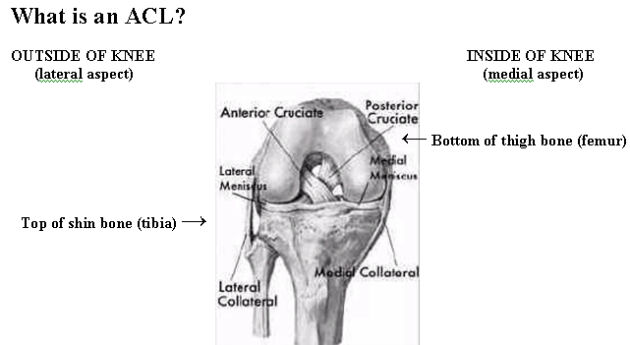ACL Injury Prevention
by Heather Harmon, MPT, Optimal Performance Physical Therapy, LLCScarborough, Maine

The ACL, or Anterior Cruciate Ligament (see above), is a very important band of tissue deep in the knee that helps keep the knee stable. More specifically, it keeps the shin bone (tibia) from moving forward relative to the thigh bone (femur), and also helps restrain the tibia from twisting inward relative to the femur.
How do ACL injuries occur?
ACL injuries can be quite grotesque and traumatic due to a contact injury – for example, a football player is tackled just below the knee joint, his ACL tears, and the knee basically just folds in half backwards – ouch!
But, more than 75% of the time, ACL injuries occur from non-contact injuries. Non-contact injuries include ACL tears sustained while trying to perform a change in direction / speed / momentum maneuver - for example: planting and cutting, twisting, landing from a jump, or trying to stop suddenly. Most ACL injuries are just that innocuous…as if blowing out their knee isn't bad enough, many ACL-injury-sufferers don't even have a good story to tell about how they got injured! - it's usually just "I was a little off balance, and I stepped/landed funny." It doesn't seem like it would be possible to sustain such a serious injury from something athletes do thousands of times in a game/competition, but unfortunately it is!
Interesting Facts...Female vs. Male
Depending on the athletic activity, non-contact ACL injuries are 4-8 times more likely to occur in females! Why? Well, the jury's still out. There is currently a lot of research being done in this area to study the differences between males and females that may account for the increased risk of injury. Some factors being studied include differences in the anatomical alignment of the bones and muscles in the lower extremities, joint laxity/looseness, hormonal fluctuations, knee joint structure and size of the ACL, muscle strength and firing patterns, and training regimens. Thus far, research has not been able to isolate one particular risk factor that makes women more susceptible to an ACL injury...the more likely explanation is that the increased risk is because of a combination of these factors.
Surgery or No Surgery? That is the question...
ACL tears do not heal by themselves. Deciding whether or not to perform a surgical reconstruction of the ACL after a tear depends primarily on the person who sustained the injury - including their age, level of activity, plan to return to sports, and the extent of the injury. It is possible to function in life without an ACL - the muscles around the knee can be trained to stabilize the knee joint, so many people choose not to have surgery; however, in competitive athletes - especially in young athletes, ACL injuries most often require surgical reconstruction to effectively stabilize the knee joint, prevent further injury, and reduce the risk of early-onset arthritic changes. Post-surgically, at least 3-6 months of physical rehabilitation is required to return to sport. So, as you can see, ACL tears are a time and energy-consuming injury, not to mention the significant financial costs incurred.
The Good News!!!
Recent advances in sports training programs have proven effective in significantly reducing the risk of non-contact ACL injuries. Some preliminary studies are reporting up to 80% reductions in non-contact injury rates with implementation of specific training regimens. ACL Injury prevention programs are aimed at training athletes to avoid vulnerable positions, enhance muscular control and firing to support the ACL, and improve balance and coordination. Most programs can be used in place of a traditional (and, let's face it, sometimes mundane and relatively outdated) warm-up routines both prior to and during the season. Some programs are sport-specific, concentrating on especially high-risk sports such as basketball and soccer, but the general principles of most programs are the same, and can be applied to almost any sport.
It is good to know that we can make efforts to decrease the risk of this devastating injury in athletes of all ages. Don't think it can't happen to you - because, invariably, it may. It only takes a little time and effort to invest into the health of your knees for now and forever. It's worth it...because happy knees make happy athletes.
Heather Harmon is a physical therapist at Optimal Performance Physical Therapy in Scarborough, Maine. Optimal Performance is a privately-owned practice dedicated to providing quality healthcare services to individuals of all ages and abilities. For more information about the practitioners, services, and treatments, please visit http://oppt.com/.
Herb's Tips and More
-
 Did you know that you can make soap, candles and lotion with your herbs?
Did you know that you can make soap, candles and lotion with your herbs? -
 Never take any herb identity for granted. The best way to be sure that you are using the right kind of herb is by buying it.
Never take any herb identity for granted. The best way to be sure that you are using the right kind of herb is by buying it. -
 Excellent health articles whether you are looking for information or inspiration regarding preventive health or are dealing with a medical
challenge.
Excellent health articles whether you are looking for information or inspiration regarding preventive health or are dealing with a medical
challenge.









